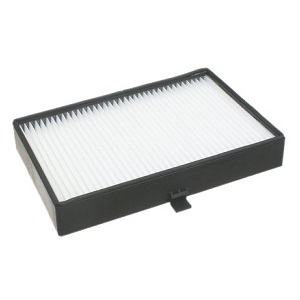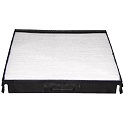
Function of a Cabin Air Filter
Your cabin air filter’s function is to screen airborne particulate such as dust and pollen out of the air entering your vehicle. It operates based on the same principles that your engine air filter operates on. Most cabin air filters are made with paper or cotton fiber elements, and air is forced to pass through these elements prior to entering your cabin. The filter elements are designed to trap particles larger than a certain size. Accordingly, over time, particles will build up and remain trapped in the filter element, eventually reducing the efficiency of your climate control system due to a reduction in airflow through the filter. In order to avoid this, the filter must be routinely changed in order to prevent particulate build up from impeding air flow.
Common Symptoms of a Bad Cabin Air Filter
Poor Air Flow From Vents
One of the most common issues with a cabin air filter is that you will notice reduced air flow from the vents when the filter is dirty. This is because air has a more difficult time passing through a cabin air filter that is dirty or clogged.
Odors
An excessively dirty cabin filter can produce an odor when using the venting system. A clogged filter provides an outstanding place for molds and mildew to proliferate, particularly when the particulate trapped in the filter is exposed to moisture from the air, such as on humid or rainy days.
Filter Appears Dirty
One of the easiest ways to monitor the health of your cabin air filter is to look at it. Most new filters will be a bright color (white, pink, yellow etc.) and visibly clean. Over time they will turn gray or brown as more particles become stuck in the filter element. Your owner’s manual should specify the frequency the filter should be changed, although there are certain instances where you may consider changing the filter more often (one such example is if you were driving in proximity to wildfires). If your owner’s manual doesn’t have a regular replacement period listed, consider an annual inspection and replace as necessary.
Replacing a Cabin Air Filter
When you’ve determined that your air filter needs to be replaced, the task is relatively straightforward, even for novice mechanics.
Note: The example steps below are intended for general informational purposes solely to help give you an idea of project difficulty and tools required. As all cars are engineered differently, repair procedures and safety hazards vary from vehicle to vehicle. To ensure that you have a vehicle specific repair procedure and an exhaustive list of potential safety hazards, we advise you reference a factory service manual for your vehicle. Similarly, referencing a repair manual such as Chilton or Haynes might serve as a less expensive alternative.
Step 1 – Most cabin air filters are located inside or underneath the dashboard of your vehicle. Most of the time it will require either the glove box or a cover under the dash to be removed for access. Sometimes accessing the cabin air filter requires removal of fasteners, which is best accomplished with a screwdriver, a ratchet and socket, or hex keys depending on the type of fastener.
Step 2 – Once the cover is removed, slide the filter out. It may be installed in the cover itself, or it may be behind the cover, depending on the make and model of vehicle.
Step 3 – Replace the filter with the new one, checking to make sure the new part fits correctly. Cabin air filters typically do not require oiling or other preparation steps that some types of engine air filters require.
Step 4 – Once the new filter is in place, replace the cover and turn on your climate control system to test to verify that you have the appropriate amount of airflow coming from the vents.
Best Cabin Air Filter Brands
When it comes to selecting a replacement cabin air filter for your vehicle, there are many brands out there to choose from and the decision can be tough one to make. To help narrow your search to save you some time, we have provided a short list of our favorite cabin air filter brands below as we have found them to be a good balance of quality and value.
NPN
 NPN has been providing high quality filters to OEM and aftermarket customers for a long time. They make a high quality product at a reasonable price, which is nice as you will achieve good filtration without breaking the bank. NPN makes multiple lines of filters, depending on your taste and level of filtration you desire. Their filters typically are backed by a strong warranty that often outlasts the replacement interval outlined in your owner’s manual, which should give you a vote of confidence when installing an NPN cabin filter in your vehicle.
NPN has been providing high quality filters to OEM and aftermarket customers for a long time. They make a high quality product at a reasonable price, which is nice as you will achieve good filtration without breaking the bank. NPN makes multiple lines of filters, depending on your taste and level of filtration you desire. Their filters typically are backed by a strong warranty that often outlasts the replacement interval outlined in your owner’s manual, which should give you a vote of confidence when installing an NPN cabin filter in your vehicle.
Click here to find an NPN cabin air filter for your vehicle.
Hastings
 Hastings has been making and distributing filters for many decades. They make a large variety of filters, so it is highly likely that they make a replacement part for your vehicle. Hastings has a nice balance between quality and cost, in that their parts are affordable while also robust enough to ensure long lifespan. Overall, we think you’ll be satisfied if you opt to install a Hastings cabin air filter in your vehicle for your next replacement.
Hastings has been making and distributing filters for many decades. They make a large variety of filters, so it is highly likely that they make a replacement part for your vehicle. Hastings has a nice balance between quality and cost, in that their parts are affordable while also robust enough to ensure long lifespan. Overall, we think you’ll be satisfied if you opt to install a Hastings cabin air filter in your vehicle for your next replacement.
Click here to find a Hastings cabin air filter for your vehicle.
